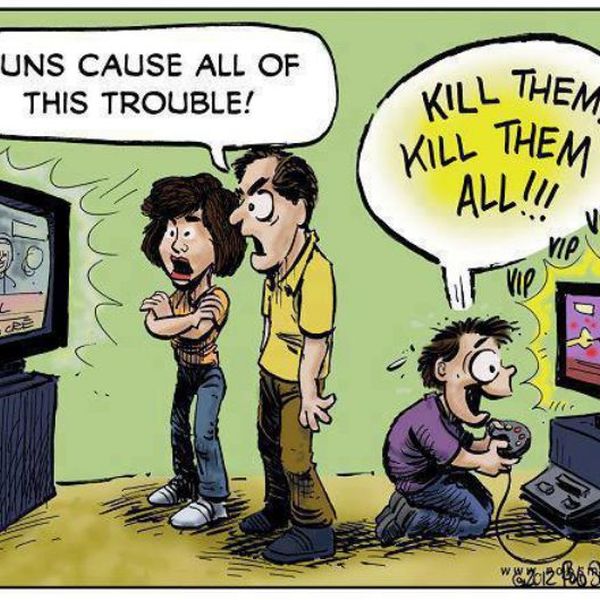On average, young Americans spend more than 45 hours per week watching all forms of media. Nowadays, children are surrounded with televisions, video game consoles, computers, etc. Children use television as their primary source of media entertainment, nevertheless technology and electronic devices are advancing daily. Additionally, more and more people are viewing violent content because of its increased access. Currently, 98 percent of all American homes own at least one television set. Moreover, most electronic devices can run games. Since technology is continuously advancing, more and more of the future generations are bound to be associated with video games. Thus, one can conclude that aggression and violence can develop in younger generations from exposure to the current media.
For the majority of people’s living rooms, there is a violence medium/box that is often unnoticed, the TV. Kids who view tv a lot are often drawn into its realistic world of violence scenes, which causes detrimental outcomes. Statistics show that child deaths and arrests as a result of abuse committed by other children have increased. Also, children that mimic violent characters in the media and display aggression generally become insensitive and assume that violence may occur without consequences. Experts say children think that violence is a suitable way to deal with problems and conflicts. (Schleifer 18) In California, a seven-year-old boy dredged the lamb stew the family was going to eat for dinner with ground-up glass. In Ottawa, another boy was caught spinning the family cat by the head and when his mother attempted to stop him he said, ‘It’s just like Michelangelo, one of the Ninja Turtles.’ (Miller 70) Once asked why he did it he claimed that he wanted to know whether it would have the same effect in real life as on TV. (Howe 72). Hence, the television can cause devastating effects and blur the line between right and wrong.
Does playing violent video games cause children to act aggressively? Because teenagers and children spend an immense amount of time each day playing video games, they are molding their behaviors, attitudes, and values. For three consecutive days, students who played violent video games for 20 minutes showed increasing levels of aggressiveness each day. (Bushman 1) According to Brad Bushman, a professor of communication and psychology at Ohio State University, his research demonstrates that students who play violent video games sequentially have violent habits. If a video game player does not immediately imitate particular violent acts found in video games, the game will still have a long-term negative impact on that player’s behavior and perspective. Craig Anderson and his colleagues surveyed children that play video games in Japan and U.S. and analyzed how teens and children’s video game habits at one time contributed to their behavior after three to six months. Their study revealed that children who were exposed to more video game violence did become more aggressive over time than their peers who had less exposure. “ Those who played multiple violent video games become more physically aggressive. Multi-sample structure equation modeling revealed that this longitudinal effect was of a similar magnitude in the U.S. and Japan for similar age youth.” (Anderson 2). This was valid even though the researchers considered how the aggressiveness of the children at the start of the study – a strong indicator of potential violence.
So can viewing violent media trigger aggression behavior in kids? The answer is clearly yes. As proven by numerous studies, media violence results in aggressive behavior in the real world. These studies reliably demonstrates that violent media content increases the likelihood of aggression, especially in youths. Then, it’s we are what we eat. Now, it’s we are what we play.

